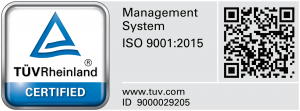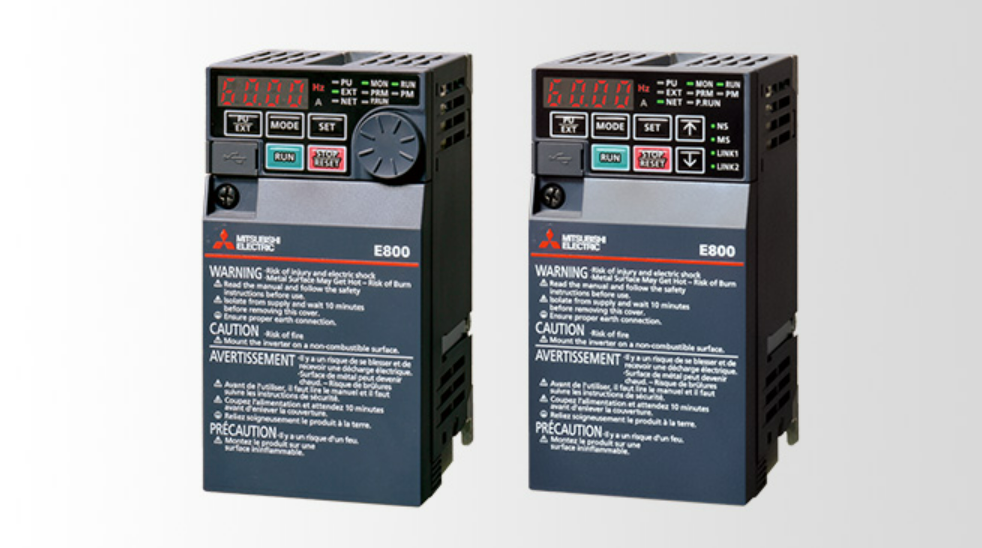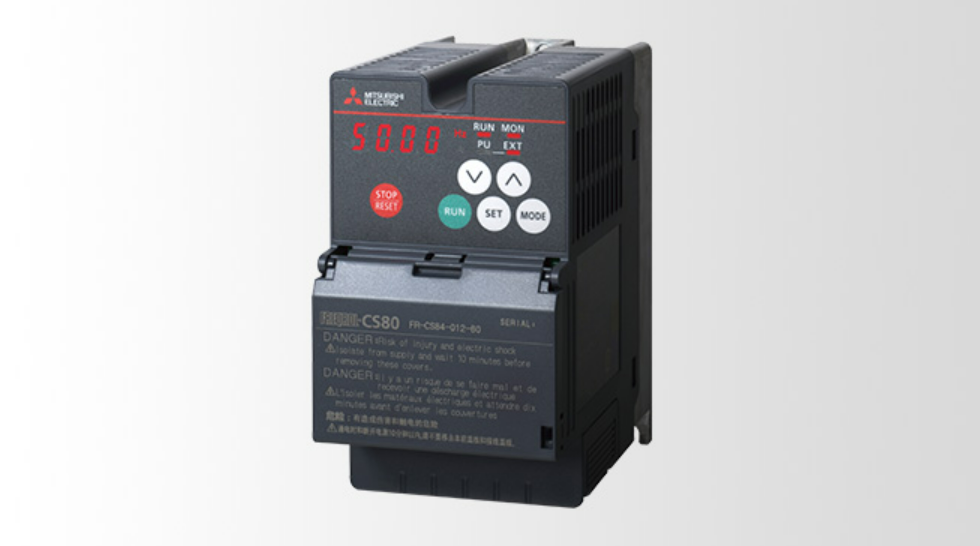

An essential component of today's dynamic industry is accurate and effective control of electric power. As a leader in cutting-edge technology, Mitsubishi Electric has continuously provided creative solutions to satisfy the changing demands of diverse industries. The FREQROL series of inverters is one of their most notable products and demonstrates their dedication to providing superior power regulation. On top of that, Mitsubishi Electric has made significant advancements in power electronics with its FREQROL line of inverters. With their ability to manage electric motor speed, torque, and efficiency, these inverters offer unmatched control over industrial processes. FREQROL inverters guarantee peak performance, reduced energy consumption, and heightened productivity in many sectors, including manufacturing, energy, and infrastructure.

FR-A Series (Credit to Mitsubishi Electric Website)

FR-E Series (Credit to Mitsubishi Electric Website)

FR-CS Series (Credit to Mitsubishi Electric Website)
Moving on with some key features and advantages such as precision control where the FREQROL inverters offer precise control over motor speed and torque, allowing for seamless integration into various applications. This level of control not only enhances efficiency but also extends the lifespan of connected machinery. Besides that, with a focus on sustainability, Mitsubishi Electric has engineered FREQROL inverters to optimize energy consumption which is energy efficiency. This not only results in cost savings for businesses but also contributes to a greener and more eco-friendly operation. Furthermore, the FREQROL series is versatile, capable of meeting the demands of diverse industries. From constant torque to variable torque applications, these inverters provide adaptable solutions for an array of operational requirements.
Other than that, it is reliable and durable where Mitsubishi Electric's commitment to quality is evident in the robust design of FREQROL inverters. Built to withstand challenging environments and rigorous usage, these inverters ensure uninterrupted operation, minimizing downtime and maintenance costs. Finally, it is smart and connected whereby it embraces the era of Industry 4.0, FREQROL inverters come equipped with smart features for remote monitoring and diagnostics. This connectivity enables predictive maintenance, reducing the risk of unexpected breakdowns and optimizing overall system performance.
Apart from that there are also applications across industries such as in oil and gas industry there are the pump and compressor control where FREQROL inverters can be used to control the speed of pumps and compressors, providing efficient and precise control over fluid flow and pressure in oil and gas extraction and processing operations.
Besides that, would be energy savings where variable frequency drives (VFDs) like FREQROL can optimize energy consumption by adjusting motor speed to match the actual process requirements, reducing energy costs in pumping and compression applications. Not only that, it also applies in harmonic mitigation as FREQROL inverters can help mitigate harmonic distortion in electrical systems, ensuring the reliability of sensitive electronic equipment used in the oil and gas industry.

Besides that, for the general industry there are the conveyor systems where FREQROL inverters can be applied to control the speed of conveyor belts, optimising material handling processes in manufacturing and logistics. Next, would be the fan and pump applications whereby in general industry settings, FREQROL inverters are often used to control the speed of fans and pumps, leading to energy saving and improved process efficiency. Other than that, inverters play a crucial role in the automation of various industrial processes, allowing for precise control and coordination of machinery.

Inverters in Conveyor Belt (Credit Image to Mitsubishi Electric)
Moving towards the marine industry, the applications would be the FREQROL inverters can be employed in ship propulsion systems to control the speed of electric motors driving propellers, offering better fuel efficiency and maneuverability. Another would be the inverters are used in the marine industry to generate and control electrical power on ships, optimizing the performance of generators and electrical systems.

Inverters in Ships propellers (Credit Image to Hongfen Bai, 2020)
Finally, in regards with the oil palm industry where FREQROL inverters can be used to control the speed of motors in various stages of the palm oil extraction process, such as sterilization, threshing, and oil extraction, optimizing production efficiency. Lastly, In the oil palm industry, conveyors and elevators are used for the movement of palm fruits. FREQROL inverters can be applied to control the speed of motors driving these systems.

Oilseed scraper conveyor (Credit Image to oil-mill-plant.com)
CC-Link networks with Mitsubishi Electric FREQROL inverters lie in the seamless integration and control of industrial automation systems. For CC-Link IE TSN and CC-Link IE Field Network where its emphasis more on communication infrastructure that facilitate real-time and reliable communication between various devices in an industrial setup, including Mitsubishi Electric's FREQROL inverters. These networks enable FREQROL inverters to seamlessly connect with other components in an automation system, such as programmable logic controllers (PLCs), human-machine interfaces (HMIs), and other field devices. As for CC-Link IE Field Network Basic would be emphasizing more on cost-effective connectivity solution for applications with less complex communication requirements. It ensures that FREQROL inverters can be integrated into industrial networks in a scalable and economical manner.
As for iQ Works which is a comprehensive software suite, is instrumental in programming and configuring various Mitsubishi Electric automation products, including FREQROL inverters. It allows seamless integration of FREQROL inverters into the overall automation system by providing a unified platform for programming and configuration of different components. Next, for FR Configurator 2 which is specifically designed for configuring and programming Mitsubishi Electric's frequency inverters, including the FREQROL series. The software enhances the ease of integration and optimization of motor control systems, ensuring that FREQROL inverters operate efficiently within the specified parameters.
Finally, would be the iQ AppPortal which allows users to develop and deploy custom applications for Mitsubishi Electric's PACs, PLCs, and other devices, creating a tailored solution for specific industrial automation needs. This platform can be utilized to create custom applications that enhance the functionality of FREQROL inverters or provide additional features based on the unique requirements of a particular application.
In conclusion, Mitsubishi Electric's FREQROL inverters stand as a pinnacle of innovation, providing precise control over motor speed and torque for diverse industrial applications. With a focus on efficiency, sustainability, and adaptability, these inverters offer unparalleled advantages across sectors such as manufacturing, energy, and infrastructure. Their reliability and durability ensure uninterrupted operation, minimizing downtime and maintenance costs.
Additionally, FREQROL inverters play a vital role in various industries, from optimizing energy consumption in oil and gas operations to enhancing material handling processes in manufacturing. Their smart and connected features align with Industry 4.0, enabling remote monitoring, diagnostics, and predictive maintenance. Whether in ship propulsion systems, electrical power generation on ships, or the oil palm industry, FREQROL inverters consistently deliver peak performance and efficiency, showcasing Mitsubishi Electric's commitment to advancing industrial automation.
Servo: A servo system is a closed-loop control system that uses feedback to maintain desired output. In the context of motors, a servo motor is a type of motor that is controlled with precision to achieve specific angular positions.
Inverter: An inverter is an electronic device that converts direct current (DC) to alternating current (AC) or vice versa. In the context of motor control, an inverter is often used to control the speed of an AC motor.
Servo: Servos are commonly used in applications where precise control of position, speed, and torque is required. Examples include robotics, CNC machines, and other applications where accurate and dynamic control is necessary.
Inverter: Inverters are used to control the speed of AC motors, such as induction motors and permanent magnet synchronous motors. They are commonly employed in variable frequency drive (VFD) systems for applications like pumps, fans, and conveyor systems.
Servo: Servo systems typically employ closed-loop control, where feedback from sensors (such as encoders) is used to continuously adjust the motor's operation to achieve and maintain the desired position or speed.
Inverter: Inverters can be part of open-loop or closed-loop control systems. In a closed-loop system, feedback is used to adjust the motor's speed, while in an open-loop system, the speed is controlled without direct feedback.
Servo: Servo motors can be AC or DC motors, and they are designed for high precision and responsiveness. DC servo motors and AC servo motors are both common types.
Inverter: Inverters are typically associated with AC motors. They are commonly used to control the speed of AC induction motors or permanent magnet synchronous motors.
Servo: Servo systems often use pulse-width modulation (PWM) signals for control. The width of the pulses determines the position or speed of the motor.
Inverter: Inverters receive control signals that vary the frequency and amplitude of the output voltage, allowing for the control of motor speed.
FREQROLS refers to the capability of an inverter to regulate both frequency and voltage output
Frequency regulation ensures that the AC power output from the inverter matches the standard frequency used by electrical appliances
Inverters use feedback systems and control mechanisms to adjust the voltage output and maintain it within acceptable limits.


